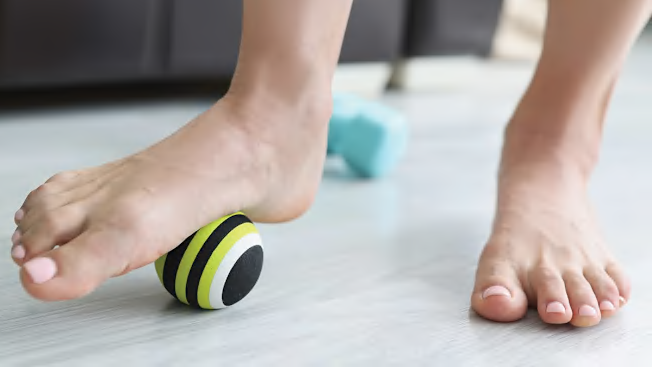How to Relieve Heel Pain
If your heels are achy, stretches, the right footwear, and shifting your activities a bit can really help

Bunions, corns, and curled-up hammertoes are among the more obvious causes of foot pain. But when it comes to your heels—a source of discomfort for almost 10 percent of adults ages 50 and up—it may be less immediately clear.
"Older patients often write it off as just another inevitable side effect of aging or blame their heel pain on arthritis," says Stephanie Hook, DPM, executive director of the American Board of Podiatric Medicine. "But the typical area of pain is not at a joint, so arthritis is likely not the case." So why are your heels hurting? Below, common conditions and steps for relief.
Why Heels Hurt
Plantar fasciitis and Achilles tendinitis are two of the main reasons your heels might ache. The first is caused by excess pressure on the plantar fascia, which is a band of tissue that attaches the heel bone to the toes, and the second is caused by overuse of the Achilles tendon, which connects calf muscles to the heel bone. Both can bring heel pain after a rest (for example, when you first get out of bed) as well as after exercise.
What You Can Do
If heel pain comes on suddenly and is severe, alert your doctor to make sure it’s not something that needs immediate attention, such as a torn tendon. Otherwise:
- Do stretches that soothe. Stretching the calf and Achilles tendon a few times throughout the day can help alleviate plantar fasciitis and Achilles tendinitis discomfort. Because pain is often worst first thing in the morning, it’s helpful to do this calf stretch before you even get out of bed: Place a towel, belt, or strap around the ball of the affected foot. With your leg straight, gently pull your toes toward you and hold for 15 seconds.
- Rub away pain. To ease plantar fasciitis, roll a ball, such as a golf ball, up and down the arch of the foot and along the sides to help loosen tight tissues. Rolling a frozen water bottle under your arch for 10 to 15 minutes a few times a day will also help.
- Assess your footwear. It’s key that shoes are in good condition and offer arch support. Otherwise, they may "cause strain on the plantar fascia and the Achilles," Sutera says. For any kind of heel pain, skip going barefoot, even around the house, and choose footwear that has some cushioning, a slightly raised heel, a wide toe box, and a deep heel cup that hugs your heel and helps stabilize the foot. And make sure you’re wearing the right shoes for the activity you’re doing. For pickleball, for instance, you’ll want sneakers made for racket sports, which offer support for the side-to-side motion of the game. Walking sneakers are meant for forward motion only.
- Use the right insoles. To make footwear more comfortable for plantar fasciitis or Achilles tendinitis, try drugstore insoles with good arch support. If you think a thin fat pad is the culprit, a cushioning insole with a cupped heel is best. "That squeezes your heel gently and holds it in place to help optimize whatever is left of your fat pad," Sutera says.
- Switch up activity. If something you’re doing seems to worsen pain (this typically involves impact, like walking, jogging, or a racket sport), give it a rest. Try an activity that’s easier on your heels, like swimming, riding a stationary bike, or water aerobics.
When to Get More Help
If your heel pain hasn’t subsided after two weeks of diligent self-care, it’s time to see a podiatrist. Custom orthotics can add arch support and heel padding to your shoes. A podiatrist (or physical therapist) can show you how to tape your heel to compensate for fat pad loss, Sutera says. Cortisone injections can help relieve severe heel pain from inflammation on the plantar fascia.
Editor’s Note: This article also appeared in the June 2024 issue of Consumer Reports On Health.
















